I would venture to say…
The vast majority of homesteaders got their start by strolling the aisles of the feed store and happening upon those tubs of fluffy, chirping chicks. They’re hard to resist, y’all.
And as we all know, chickens are the gateway drug to the more hardcore forms of homesteading– goats, cattle, hogs… you know the drill.
Even though we’ve been doing this homesteading thing for nearly seven years, I still get excited when it’s chick time. I’ve been slightly disorganized with my chick-purhases the last two years (a new baby and a major home remodel will do that to ya…), so I’m rather proud of myself for ordering early this year.
We just got 15 Silver-Laced Wyandottes, as well as 30 Cornish cross meat birds. After having a mis-matched variety of layers over the years, I’ve decided to stick with one breed and plan to selectively breed them for desired traits. I figure it’ll be the next step in up-leveling our chicken operation.
Last year was our first year raising our own meat birds, and we’ve enjoyed the harvest so much, I couldn’t wait to do it again. We got 30 meat birds this go-round, and will order 30 more later in the year.
Preparing for chicks isn’t complicated, and as long as you keep a few factors in mind, you’ll be just fine. However, if this is your first time getting chicks, I totally understand how it can feel slightly daunting. After all, they can be rather fragile and you want to make sure you’re caring for them adequately. If you keep these five factors in mind, you’ll be just fine:
Preparing For New Baby Chicks
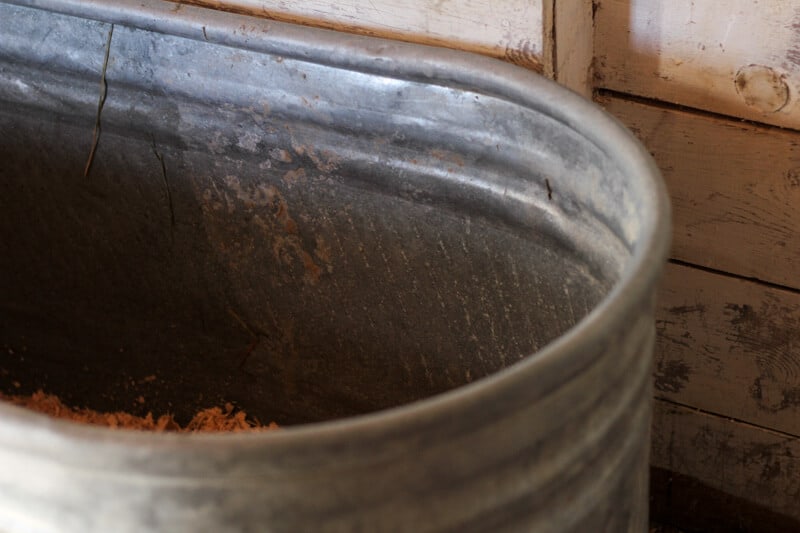
1. The Brooder
A brooder can be fancy or simple– it’s up to you. Basically, you just need some sort of “container” for the new chicks. If you turn them into a large coop right away, it’s easy for them to get stuck in crevices or corners, which can be deadly when it’s chilly outside. You can purchase fancy brooders, or just use what you have at home.
I personally have used large galvanized water tubs for years– they are tall enough they can’t fly out and they don’t have corners for them to get stuck in. Other options would be plastic tubs, crates, cardboard boxes, or even old playpens.
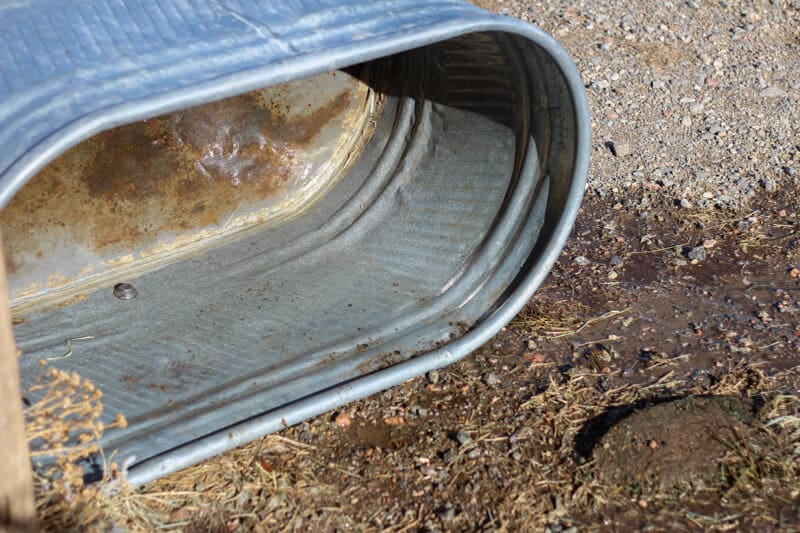
Once you have your brooder selected, you’ll want some sort of non-slip bedding on the bottom– we have always used pine shavings, but other options are puppy pads, paper towels, or even sand.
Plan on cleaning the brooder every couple day or two. You probably won’t have to completely strip it every day, but I check it frequently and remove areas of wet bedding or the super poopy stuff.
I don’t put a cover on my brooder, but if you have any sort of potential predators (including cats), I would definitely place chicken wire or mesh over the top. Just make sure you don’t use a cover that would block their ventilation at all.
You can get away with a fairly small-sized brooder at the beginning, but if you have a large batch of new chicks, plan on expanding soon. The little buggers will grow faster than you think!
2. Heat
I’m not a fan of using heat lamps for my big chickens, as they are such a fire hazard. However, heat is non-negotiable for babies. Chicks must be kept at 95-100 degrees for their first week or so of life, with the temperature gradually being decreased as they grow.
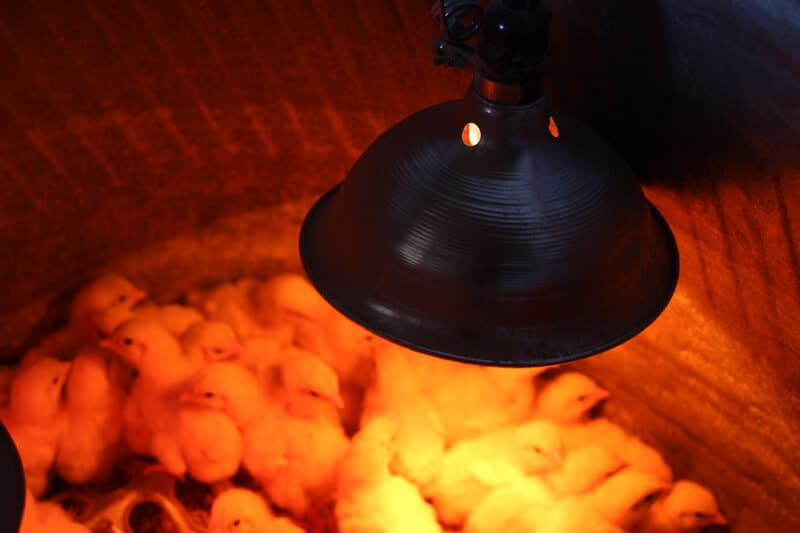
The simplest option here is a good old-fashioned heat lamp, obviously. However, If you go this route, be EXTREMELY cautious with it, as heat lamps can be considerable fire hazards. (If you are using a heat lamp, I would definitely not recommend using a cardboard box as your brooder, by the way…)
A safer option is a heating plate. Nope– these aren’t cheap– especially if you have a large amount of chicks. But you’ll likely sleep better at night not having to worry about the coop burning down.
I have this Brinsea EcoGlow Brooder— it works decently well for small batches of chicks.However, for larger batches I still use heat lamps.
I don’t use a thermometer in the brooder. Rather, I just let the chicks tell me how they are doing temperature-wise. If they are plastered against the sides of the brooder trying to get away from the heat lamp, I know they are too hot and I need to raise the lamp or move it. If they are huddled in a bunch as close to the lamp as possible, I know they are cold and I need to lower it or add another heat source. This is another reason heat plates are handy– the chicks can choose to stand underneath if they are cold and can easily get away from it if they are too hot.
3. Water
Just like with any other living thing, water is a big deal for new chicks. When I first pull them out of their box, I gently dip their beaks into the waterer so they know it’s there.
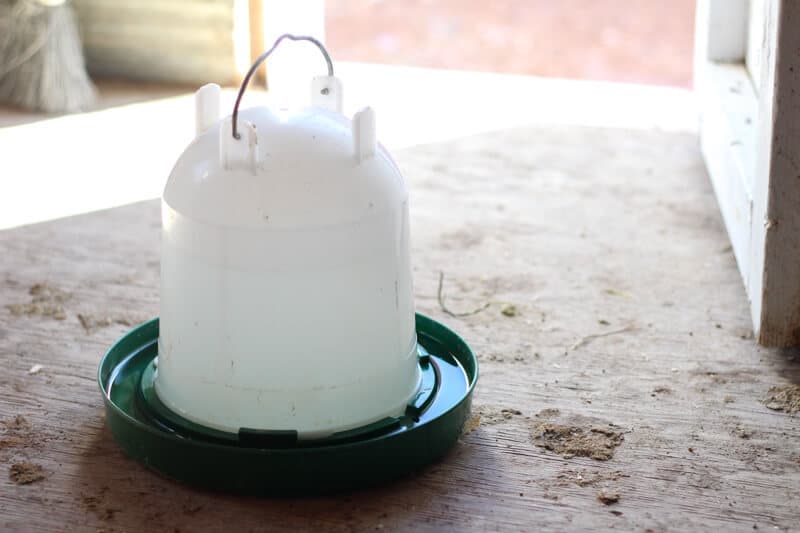
I highly recommend using a special chick waterer of some sort, as an open bowl leaves your new flock at risk for drowning. I wrote up this DIY chick waterer tutorial a long time ago, and the method still works. Although to be honest, I just buy the cheap plastic waterers from the feed store now. 😉
Make sure the chicks water stays somewhat warm and full at all times.
4. Feed
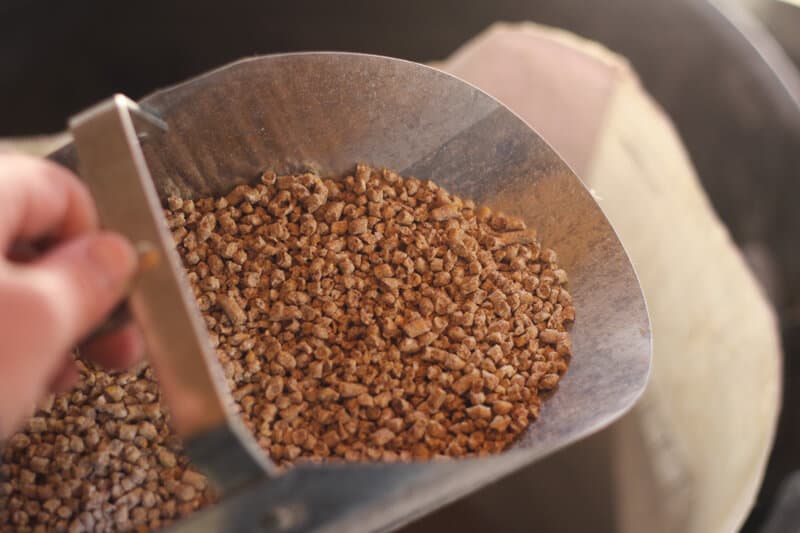
I go the lazy route on this one and simply purchase the chick starter feed from the local feed store… Scandalous, I know. I’m sure there are DIY chick starter recipes out there, but honestly? New chicks have very specific nutritional requirements at this point of their life since they grow so quickly, and it’s easier to just grab a bag from the feed store. Not to mention, they don’t stay on the chick starter for very long before transitioning to either meat bird feed or layer feed. (At that point, it’s easier to get more creative, if you wish.)
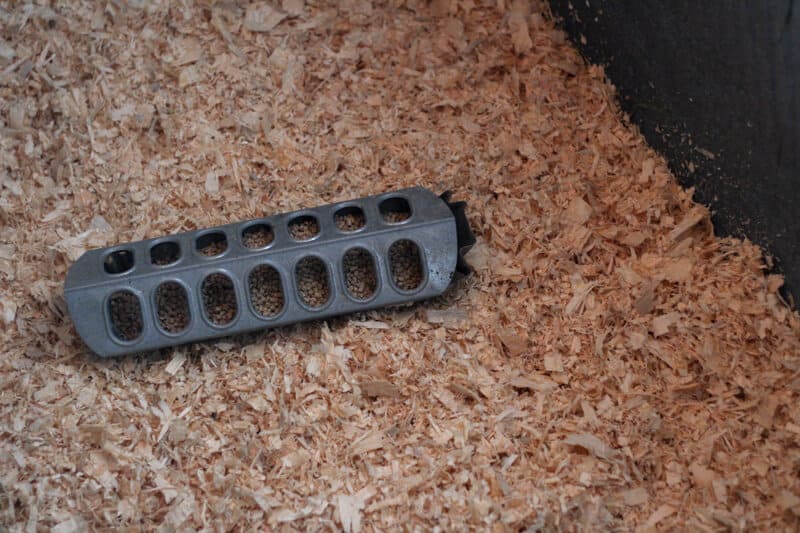
I use this cute little chick feeder for the first couple of weeks, but it doesn’t take them long to be needing a larger feeder. And they’re messy little guys, regardless. They spill everything and walk in it as much as possible…
New Chick FAQ:
Q: Do I need to worry about sanitizing my brooder and all the accessories?
A: I suppose it depends on who you talk to. I used to go nuts “sanitizing” everything, but have since stopped doing that. A while ago I read Harvey Useery’s book where he talked about chicks potentially benefitting from healthy bacteria and microorganisms in their environment. This makes total sense to me as I know that’s totally how it works with humans (especially kids). Since then, I stopped sanitizing or bleaching anything when I’m preparing for chicks. I just give everything with a good scrub of fresh water and maybe a bit of natural soap, and that’s it. Now if I had been dealing with sickness or disease of any kind in my flock, I would definitely disinfect everything. Otherwise, I don’t worry about it.
Q: Can I mix species of poultry in the same brooder?
A: I do– at least for the first little bit. I’ve never had issues putting chickens and waterfowl together at first. Eventually the ducks and geese get pretty messy with their water, so I separate at that point. You’ll also want to separate eventually if you need to feed different types of feed (layer vs. meat bird, etc) But if you only have one brooder set-up, I wouldn’t worry about it initially.
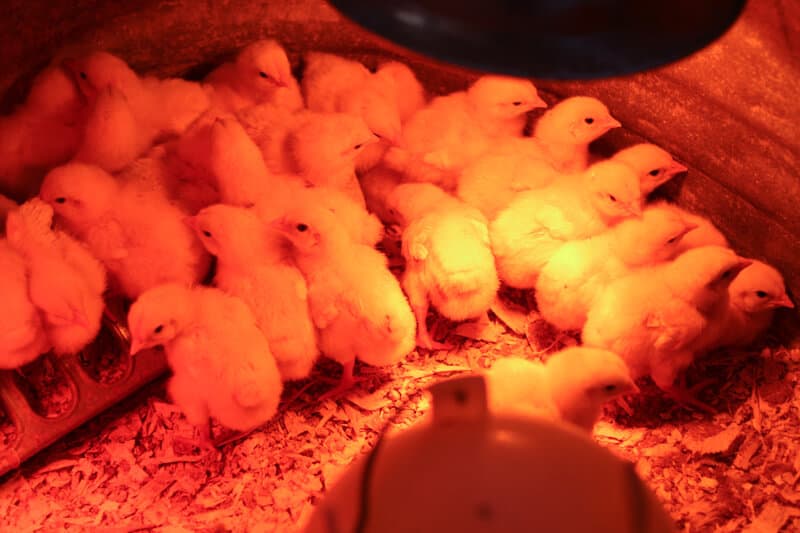
One other consideration would be if you have weak birds combined with hardier birds. We mixed our layer chicks and our meat bird chicks this time around, and ran into troubles the first day when the more robust meat birds started to trample the weaker layers who weren’t strong enough to hold their ground… So if you are mixing, watch carefully for the first little while.
Q: What about electrolytes?
A: Again, it depends on who you talk to… Some folks recommend electrolytes in the water for all new chicks, while others say only use as needed. I’ve only ever used electrolytes for stressed or injured chicks– never for the whole flock. However, if your new batch of chicks are particularly stressed or seem to not be thriving as they should, I would recommend adding a chicken electrolyte solution to their water. You can grab these at your feed store or from the hatchery, or make your own. I whipped up a batch of homemade electrolyte solution this past week when we had several injured chicks and it was borderline miraculous. Here’s the recipe so you can make your own.
Other Chicken Posts You’ll Enjoy
- All About Chicken Coops
- Homemade Chicken Feed Recipe
- How to Whitewash Your Coop
- Should I Use a Heat Lamp?
- Homemade Suet Cakes for Chickens
- Do I Have to Refrigerate Eggs?

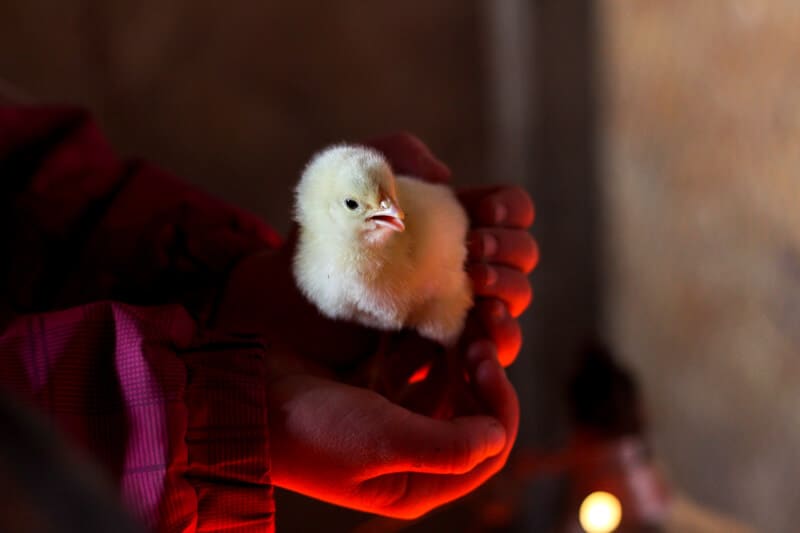



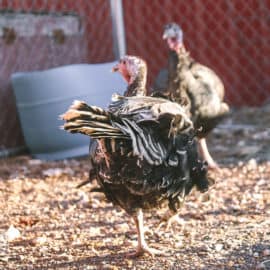

We are wanting to order a batch of chicks. Where do you get yours from? Is there a minimum?
Thanks!
Tractor Supply or your local feed store will have chicks and all the fixins to get them started.
https://www.cacklehatchery.com/
The Best!
I got them from Meyerhatchery.com this year. This is our first time using them. Not sure about the minimum, though.
Murray McMurray Hatchery – I’ve had excellent luck with their chicks for many years.
We have a farm supply store that has chicks year ’round. In the springtime a lot of feed stores will have them for about 60 days but most are straight run(boy/girls mixed) so it’s like chicken surprise, you don’t really know what you have until they are a couple of months old. If I want specific or rare breeds I think McMurray Hatchery is the best choice. I have also used Ideal Poultry since I live in Texas. When you ORDER chicks they ship via the Post Office…it’s best to call the PO about 7:30 am the day they are SUPPOSED to arrive. Picking the chicks up reduces the stress on the chicks. When I put them into the brooder at home I gave them lightly sweetened sugar water for the first couple of hours. Good luck.
Very cool you can get chicks year around at your farm store! Ours only has them in March/April.
Gotta love those little peeping balls of fluff 🙂
We’re excited for our first batch of meat birds this year! I’m surprised to hear you already have a batch…isn’t it freezing where you are? My husband decided to wait for summer weather. In your opinion, is it easier to raise chicks in the summer, or not that big of a difference?
Yes– it’s still winter here– we are just using heat lamps for them. 🙂 I think summer is probably easier– just b/c of the lack of dangerous temps.
Thank you for reminding me to stay away from the feed stores for awhile! We got carried away last year and now we’re inundated with eggs!
Oh yes… that tends to happen this time of year! 😉
Very helpful. We are still fairly new at poultry and currently have five healthy hens. We are looking to add to our flock this year when the chicks arrive at our local supply company. After reading your article I will definitely keep the electrolyte solution in mind!
Thanks
What are your thoughts on medicated vs. non medicated chick starter? Ours are showing up next week and I’m not sure which to get.
Thanks!
I definitely prefer non-medicated.
I just love the chick time of year! This year though, I promised one of my good broody hens that if she goes broody this year, I’ll let her be in charge of chicks…..She doesn’t appear have that feeling, but that’s okay, I still have plenty of laying hens.
When I do have chicks though, I always put marbles or pebbles in their water trough or bowl for a few weeks to avoid them drowning. By the way, this can be done with big rocks in the water if you have baby goats or sheep too. It can help to avoid catastrophe!
I’ve always used electrolytes with my chicks and since I’ve always had good luck with my chicks I keep using it.
Happy Homesteading!
Doneene
Usually I don’t learn post on blogs, but I would like to say that this write-up very compelled me to check out and do so! Your writing taste has been amazed me. Thank you, quite great post.|
Africaradios.com is the best place to listen All African Radio Stations in place, Enjoy live radio, music online. Bookmark favorite radio stations, Ecouter Radio Ndeke Luka EN Direct En Ligne to the top-rated and most popular radio stations from all over the world.
Ecouter Radio Comores FM Moroni En Direct is a most popular website for all type of African and European Country, we always try to provide best audio streaming for all type of Radio station or channel.
We offer Best Audio Stream of All Radio genres, Enjoy FM Radio Online Streaming as You like, Bookmark favorite radio stations, we provide top-rated and most popular radio stations from all over the world.
Here You can enjoy all type of Listen Live FM Radio Online with high best quality, i you like your stream, then kindly share for other lovers.
What’s up, everything is going perfectly here and of course every one is sharing information, that’s in fact fine, keep up writing. TV Live Online Streaming
Do you mind if I quote a couple of your articles as long as I provide credit and sources back to your blog? My blog is in the very same niche as yours and my users would definitely benefit from a lot of the information you provide here. Please let me know if this okay with you. Thank you! News TV Live Online Stream
I simply want to say I am just beginner to weblog and absolutely savored this web page. Probably I’m want to bookmark your site . You surely have good stories. Bless you for revealing your web page. Listen FM Radio Live Online
Just ordered my first batch of chicks! What size tub would you recommend for 15 chicks? I’m planning on getting a galvanized steel tub like yours. Thanks for sharing your knowledge!
The post is Very Helpful.
I wish my husband wanted to get started with chicks. We are looking to purchase our little farm now and he told me the first animal he wants to buy is a donkey. I asked why and he said, “They are cute.” I have a feeling this is going to be more difficult than I thought…
Get a Jenny! Boys get nasty and bitey!
You need two donkeys as they like company.
We’ve had chickens for years. Always got a mix of breeds. Last time we bought all Silver Laced Wyandotte’s in order to distinguish between old and new chickens. They layed well for a year. Then they went down hill and never came back. They were the best fed, beautifully housed, organically wormed, special treats chickens. Out of eight hens I got 1 egg every couple of days. This time I’m going back to a mixed breed flock. Good luck with those ladies.
I can wait to see your electrolyte recipe! I always get the green pack when the chicks are shipped. I have found this helps a lot and gets them going faster after the shipping stress. I also found the vitamin “Broiler Pack” a must for the meat-Cornish Cross and turkeys to keep their legs stronger. There is nothing worse than having a bird or a few develop poor legs or a poor leg and watching them limb around. Not plug any company, but I get these things from Murray McMurray. We have found that you can mix Guinea fowl with chickens….but NEVER…NEVER turkeys. Chickens can carry and live with coccidiosis, this will kill turkeys (a drawn out death). Yes, we did those cute ducklings too, but now they get their housing right away…just too messy!We have been married for 36 years and raising birds (and raised them as a kid too). We play with birds on side (enough to feed our us and our 5 kids) on our organic dairy farm. The couple things I have mentioned are the only things I buy for the birds and for that reason can’t be put on our organic certificate. This year we stepping out of safe brooder and trying a chicken tractor for our meat birds! That will be an exciting experiment for us! Hope this helps! No matter how much you learn….you will continue to learn more!
Lovely to read your update and looking forward to your electrolyte recipe.
I’m in Australia, and currently have five gorgeous chickies running around after their surrogate mum, chirping happily and helping to clean up the bugs under our apple trees.
It’s summer here, and of our six adult mixed breed girls, 4 went broody one after the other, two of them hiding their nests under our house…(the girls are locked in at night because of foxes but free-range during the day)…the disadvantage being when they go broody in hot weather and sit on what become stinky eggs 🙁
We went to a country fair a month ago, watched the poultry judging, and came away with a dozen “fertile” eggs. Once we caught our broody Dorking and popped her in an enclosure on the eggs, she became a full-on mum, and has raised five beautiful little Hamburg chicks. Of the dozen, six spoiled in the shell and the littlest baby was kicked by mum when she was showing them how to scratch. Perhaps if I’d had electrolyte solution it may have helped it survive…still, the process of hatching with a broody has been great and she provides all the warm and learnings that new chicks need.
Yesterday’s lesson? Come up the steps to the back door and make noise. You might get food!!
What suggestions do you have for integrating new chicks into an existing flock. I have 6 brown leghorns, but need to weed out the roosters. I’m thinking about getting a different breed this year, maybe 6 or so.
Any advice on Golden Comets?!
From my research they seem to be good layers and well tempered. They also do well in cold and heat.
Just wondering if anyone has any personal opinions!
TIA?
What are the pros and cons of free range vs in a coop? I would like to be able to sell some eggs and have a supply of meat yr round. I would like to be making money and stay as small as possible? If you have a coop how big is your chicken run? What do you fence with so that weasels don’t get in? what breeds are the best and nicest? I live in northern Alberta, we have 80acr and lots of sheds and an old barn
I would add to the FAQ section, that you may not want to mix turkey poults and chicks together, chicks can carry a parasite that turkeys are less resistant to that can cause illness in the turkeys.
Also, wanted to second the fact that mixing larger breeds of chicks with smaller can be disasterous. We had three banty chicks in with a mixed group of layer chicks last year and all of them died before I realized what the problem was. I thought they weren’t thriving, but then found the last one just being generally trampled and pushed around. I moved it to it’s own brooder, but it got very weak and died. My daughter wants a few banties, so we will have a separate brooder from the start for them this year.
How long do you keeps chicks in your brooder? When do you know it’s time to move them outside to the coop? I’m in AZ and temps here are heading into the low 90’s next week. Just got my Delaware chicks so I figure they’ll be in the brooder for two or three weeks. Does that sound about right? I’m asking because it’s been more than a decade since I raised chicks. I’ve mostly bought laying hens from other homesteaders or juvenile birds that could go straight into a coop and run.
Given how warm your temps sound, you may not even need to leave them in the brooder that long. Usually you can tell when they start growing their adult feathers, and that’s a good indication that they’ll be fine outside of the brooder.
I grew up in a large city (Vancouver, British Columbia) & then moved to a small town in northern Alberta. People here get their chicks in the mail. I worked in an office about the post office & was shocked one day to go down to the post office & hear 100’s of chicks chirping. I had no idea you could mail chicks.